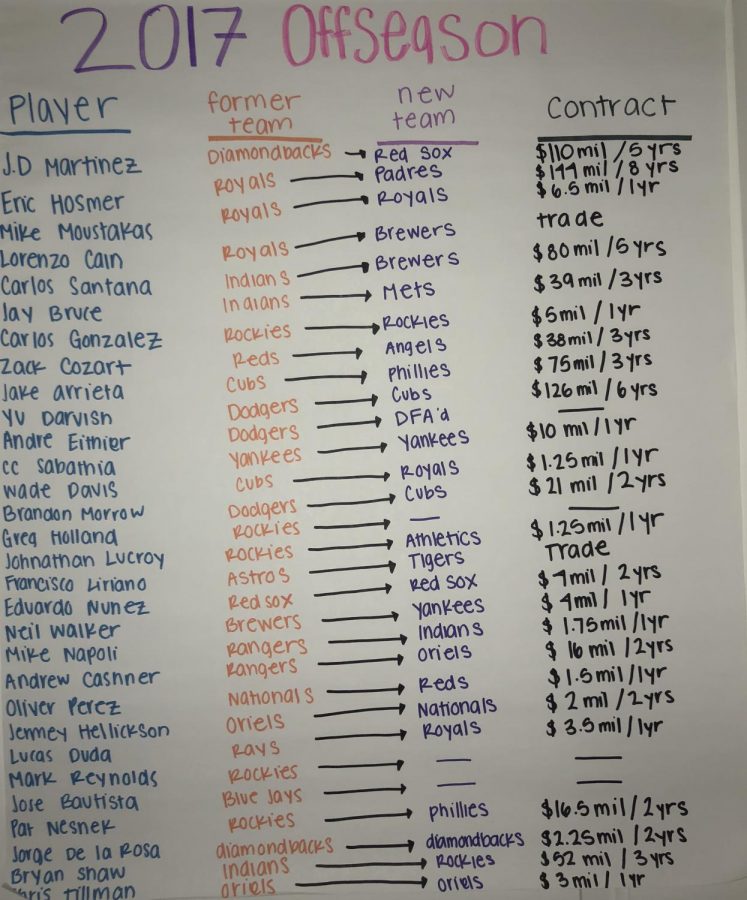Money & Math
May 23, 2018
Sabermetrics is more than numbers on a page or numbers spoken about in Major League conference rooms. It is a window in which baseball fanatics, mathematicians, gamblers, Major League scouts or Major League professionals can see the same game from a fresh perspective: a mathematical perspective. Sabermetrics combines baseball’s past and present to project the future (Great Scott!). Sabermetrics also combines passion and expression with love for the game of baseball.
Sabermetrics is one of the hidden gems about baseball that I am head-over-heels about. Every year, the day after the conclusion of the World Series I bust out a 20 x 23-inch Post-It note and record all 30 teams’ free agents. I create a color-coded chart that is filled with information on each player, their teams, and contract details. I update the chart every time a player gets traded or offered a contract. Just before Opening Day, when the chart is complete, I post it on the door of my room and bask in its glory. My offseason trade chart is filled with specifically colored names, numbers, contracts, and of course, the sources I got the information from. An entire box of markers later, I continue my sabermetric obsession by organizing each team’s starting lineups and players. I compare batting averages, earned run averages, and slugging percentages. Taking unorganized statistics and logically organizing them is my artistic expression.
I set off on a journey to explore the core definition of sabermetrics and how teams playing at the Major League level to High School level use sabermetrics to alter the play of their games.
In 1999 the Oakland Athletics hired Paul DePodesta, a Harvard economics graduate, to be the Assistant General Manager to General Manager, Billy Beane. The Athletics had just finished the season prior failing to win a World Series against the Yankees. DePodesta, only having one prior job in baseball, pitched the idea of using solely statistics to build a championship winning team. Billy Beane was desperate and agreed to give the scouting departing a makeover and stray from traditional scouting. Prior to DePodesta mathematical idea, players were either drafted, traded, or acquired based on past performance and essentially how many home runs they could hit. Paul DePodesta taught Beane that runs win games and runs are achieved when men get on base; therefore, the statistic collum scouts must pay attention to is not home runs but on-base percentage. Beane took this idea to the scouting department where the old scouts disgruntledly agreed to comply with Beanies request to acquire men with exceptional on-base percentage no matter how old, or how many home runs (or lack thereof) there are. In this moment sabermetrics took the mainstream stage.
Sabermetrics never won Oakland a World Series ring, but it did take the team to the World Series multiple times. Other teams around the League picked up on Oakland’s unique front office strategy and hired Paul DePodestas of their own. The Boston Red Sox transformed their team using sabermetrics, eventually scoring them a World Series Championship in 2004.
The other twenty-eight teams followed Oakland and Boston and jumped on the sabermetric bandwagon. Since then sabermetrics have become mainstream and trickled down to the college level and even the high school level of play.
In my investigation, I explore the essential meaning and functionalities of sabermetrics as well as how it is carried out mathematically. Sabermetrics is a tactic in the athletic arena, a lifestyle in the lives of coaches, and a spicy controversy in the eyes of scouts.
Let’s play ball!

